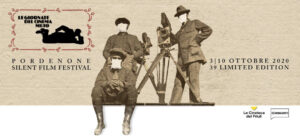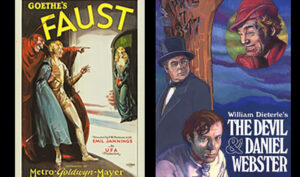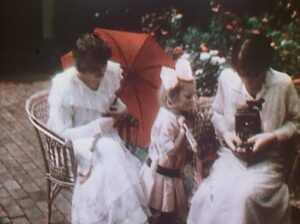
Lotte Reiniger etched her name in cinematic history with her groundbreaking animated feature film The Adventures of Prince Achmed (1926). Beyond creating the earliest surviving animated feature film, Lotte Reiniger and her entire body of work remain rather obscure today.
From her first film in 1919 to her last in 1981, Reiniger almost exclusively made films with cutout animation, meticulously animating her intricate silhouettes. Often centered around well-known fairy tales and anamorphic creatures, Reiniger’s films create unique fantastical worlds that meld the artistry of Reiniger’s intricate shadow puppets with engaging music, whether a Mozart operetta or specially composed music.
Her most well-known film, the aforementioned The Adventures of Prince Achmed, is the perfect showcase for her talents and style. A one million and one nights tale, Prince Achmed combines intricately cut-out silhouetted characters, fantastical settings, and colorfully light backgrounds to create an aesthetic and world only possible in the world of animation. Using only black paper cutouts, Reiniger makes each distinct character come to life with intricately detailed outfits and movements.
Some of the many intricately designed cutouts from The Adventures of Prince Achmed (1926).
Reiniger’s technique required a lot of talent, patience, and labor. For Prince Achmed, Reiniger spent three years working with a team consisting of such notables as her husband Carl Koch, and experimental filmmaker Walter Ruttman. All the effort was worth it to capture her whimsical films with a tempo and movement not even replicable in more conventional 2-D animation.
Existing outside of mainstream film production, Reiniger enjoyed her artistic freedom but suffered from a lack of resources. After The Adventures of Prince Achmed, Reiniger never directed a feature animated film again instead making over seventy short films. Due to World War II, Reiniger moved several times in the 1930s and 1940s having to rebuild her work area in each new country. Naturally, many of her films were not created by a large group of creatives but merely by herself with some help from her husband.
Lotte Reiniger and Carl Koch placing silhouettes to photograph.
Despite the various factors in her personal life that left large gaps in her filmography and vastly varied her budgets and distribution channels, Reiniger remained a steadfast auteur all throughout her career. Beyond employing the same animation style of photographing cut-out paper silhouettes, Reiniger returned again and again to popular fairy tales, operas, and Bible stories. Although this might sound like a small subset of stories to cull from, Reiniger’s films remain fresh with a wide variety of stories.
In Dr. Dolittle and His Animals, Reigner animates dozens of animals all with their own unique look and personality. In Papageno, she seamlessly transforms birds into fairies and back into birds again. In The Star of Bethlehem, Reiniger brings to life a flurry of flying demons that beset the three wise men on their journey to Bethlehem.
(Left) Dr. Dolittle and His Animals (Center) Papageno (Right) The Star of Bethlehem
Music plays an integral part in Reiniger’s animations. Soon after sound entered the scene, Reiniger quickly integrated her animation with both original and popular music. The most striking of her early sound animations is The Stolen Heart where musical instruments play a central role.
When a giant steals the musical instruments from a tranquil German town, the musical instruments come to life to defeat the giant and find their way back to their grateful owners. The soundtrack features numerous instruments all playing when their corresponding instrument is shown onscreen. As the instruments defeat the giant and return to the town, the soundtrack features all the instruments in harmony mirroring the triumphant and the joy music brings the quiet German town.
The instruments escape from the giant and return to the town in The Stolen Heart.
Devoid of title cards or spoken narration The Stolen Heart relies solely on the image and music to tell its story and capture the artistic expression that music brings to the townspeople. In many of her sound shorts, Reiniger placed music as a central theme if not a character like in The Stolen Heart. Her films like Papageno and Carmen frequently returned to Mozart and other famous composers to bring to life her fantastical worlds.
Even 125 years after her birth, Lotte Reiniger remains an essential figure in the world of animation. In an animation landscape dominated by photorealistic 3-D technology, we could all use the fantastical silhouettes and stories that Reiniger’s work provides.
You can currently stream a dozen of Lotte Reiniger’s films now on the Criterion Channel.
This post is an entry in The Party Like It’s 1899 Blogthon hosted by Poppity Talks Classic Films. Visit the blogathon’s main page for more great posts about other filmmakers and performers born in the year 1899.










